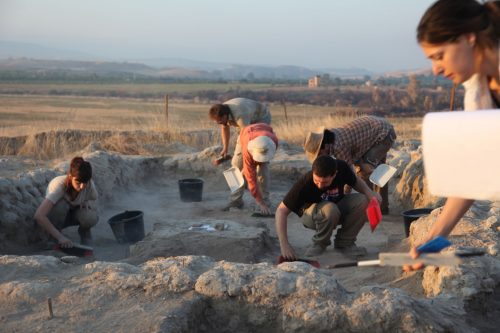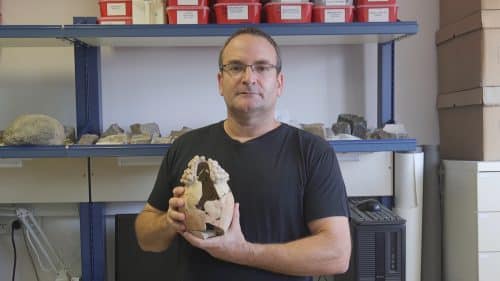Researchers from the University of Haifa found in the archaeological excavations at Tel Tsef in the Jordan Valley a unique pottery vessel from about 7200 years ago, which is the earliest evidence in the ancient Near East for a cult around food storage

The earliest evidence in the Ancient Near East for a cult related to food storage was found in the excavations of the University of Haifa and the Berlin Archaeological Institute in the prehistoric settlement of Tel Tsef: a single pottery vessel of its kind dating back 7,200 years, which for the first time reveals the ritual-religious and perhaps even political side of food storage in human societies in the Ancient Near East. "The findings at Tel Tsef are the first evidence of a link between the storage of food on a very large scale and the existence of a ritual related to the success of the storage and the preservation of the stored agricultural produce," said Prof. Danny Rosenberg from the University of Haifa who heads the research project at Tel Tsef.
The Tel Tsef archaeological site is in the Jordan Valley near the Jordan River and the international border with the Kingdom of Jordan. The site was first documented in the 40s and 50s and has been excavated intermittently since the late 70s, with Prof. Danny Rosenberg from the Zinman Institute of Archeology of the University of Haifa leading the excavations in 2013 in collaboration with Dr. Florian Klimsch from the Archaeological Institute in Berlin as part of A multidisciplinary project that includes an international team of various experts and advanced scientific methods that focuses on a careful reconstruction of the site's economy and its ancient environment.
Food hoarding has been known to researchers since the first stages of the settlement and the emergence of agriculture in the region and characterizes companies that are able to plan for the long term - that are not only concerned with 'surviving tomorrow' - because it requires thinking about the future, social organization and the distribution of the workforce and investment in infrastructure for food hoarding. Therefore, the hoarding of food in general, and that which is done on a considerable scale in particular, is an important step in the transition of humans to societies characterized by a complex social organization, and the emergence of societies characterized by the existence of a social hierarchy. According to Prof. Rosenberg, many silos for storing wheat and barley were found at Tel Tsef, which indicate the planning and reorganization of food storage. In this respect, Tel Zef is unusual for its time, because similar evidence of food storage only comes in much later periods. "The interesting thing is that in Tel Tsef we also find many botanical evidences, including thousands of seeds and other organic remains, as well as evidence of long-distance trade and various luxury items, including the earliest metal item found in our region," said Prof. Rosenberg.
According to him, during the Bronze Age (which began in our region approximately 3,300 years ago), researchers already identify societies in the ancient East, including ruling elites, but there has been a debate among researchers for many years about the way these societies began to grow. In the complex societies where elites already exist (for example, in Egypt and Mesopotamia) many evidences of ritual ceremonies related to the storage of food were found, however evidences of this type were not found in the earlier periods, therefore it was impossible to determine with certainty when and how this connection began to exist.

And here, during the excavation season at Tel Tsef two years ago, the researchers found in one of the rooms that was surrounded by excavated silos and grilling facilities (from which there are no ancient barbecues), many fragments of pottery that even at first glance seemed to the researchers to belong to a single vessel. After hard work, they managed to connect the parts and were surprised to discover a tiny and unique pottery vessel that is about 20 cm tall and has a small opening in the side - a sort of window. "The pottery we know from this period has an upper opening - like most pots and glasses in every modern kitchen - but this vessel is closed at the top, in a dome that was also covered with red-painted clay balls whose meaning is unclear," said Prof. Rosenberg.
According to the explanation of the researchers, the vessel is actually a model of the silos themselves, "a type of such vessel, which is not functional, found on the floor near a large focal point in a room surrounded by many silos and roasting facilities and also reminds us of silos that we know from the archaeological and ethnographic record from various regions of the world - it can be assumed that it was Related in some way to the silos and especially to the storage operation. We know from later evidence that humans produced vessels that symbolized large storage buildings and in fact pottery vessels similar to this vessel, but larger, appear a few hundred years later in our area and are used for secondary burials. The size of the vessel and its characteristics, along with the archaeological context in which it was found, strengthen our belief that the vessel symbolized the silos and that its use was a ritual use, perhaps as part of rituals that preceded the introduction of the wheat and barley grains into the silos or their removal," said the researcher.
The relationship between growing food and its storage and between life and death cycles of people is well known to researchers from various sources and also later finds in the ancient Near East. "When we put together all these findings from Tel Tsef, we get a picture that indicates the strengthening of the relationship between worship and increased food storage, a ritual that combines the relationship between agricultural growth cycles and the cycle of life and death, and it seems that the model of the silo from Tel Tsef is one of the earliest examples of this relationship," Prof. Rosenberg concluded .
See more on the subject on the science website:

3 תגובות
And maybe it's not from 7200 years ago but 2700 years
And maybe it's a child's toy from that time.